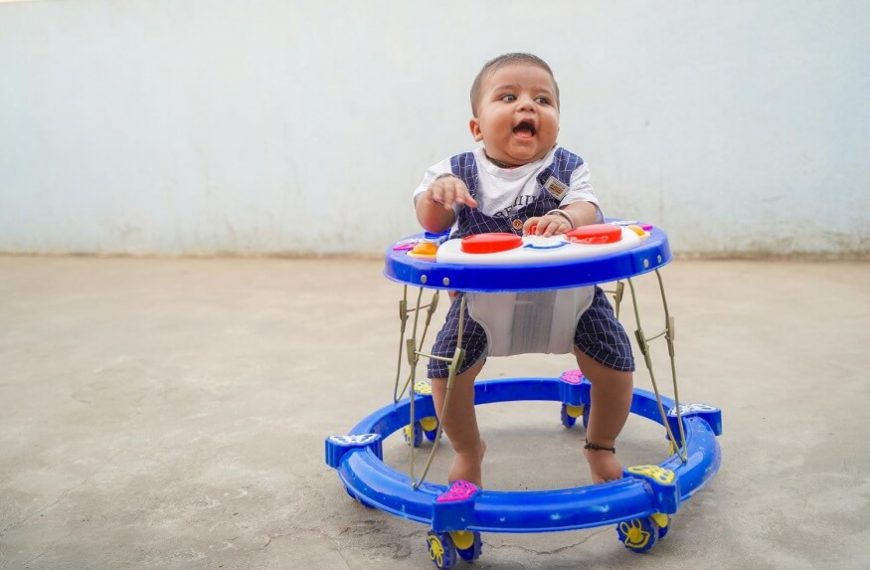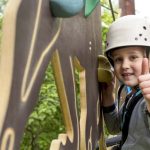As parents, we are intrigued by our child’s development on a continuous basis. We are delighted and proud of them for each and every action they do and the milestones they reach. When a newborn starts to explore their environment with a fresh feeling of curiosity and independence, it is one of the most exciting times in their early lives. The jumperoo is one instrument that has grown in popularity recently to help with this investigation. In this complete guide, we will dig into the world of jumperoos for babies, learning what they are, when they may be introduced, and the advantages they provide in assisting a baby’s developmental path.
Understanding Jumperoos: What Are They?
Let us first have a clear understanding of what a jumperoo is before discussing when newborns should begin utilizing them. A jumperoo, often called a baby jumper or an activity jumper, is a form of baby equipment used to keep babies entertained and active. Babies may bounce up and down while being held in an upright posture thanks to the seat’s connection to an elastic cord or spring. The many toys, lights, and noises surrounding the seat create a stimulating atmosphere for the infant.
Depending on your child’s ability to keep their head straight up, the amount of upper body assistance they require, and the product you’re using, you may choose when to start utilising jumperoos with newborns. To be on the safe side, we advise against placing any infant in a jumperoo until they are four months old. Although there is no “official” advice on the subject— the NHS declined to comment— we haven’t come across any jumperoos that are suggested for infants under four months, therefore, we believe that this is a reasonable rule to follow.
The Benefits of Jumperoos for Babies:
A baby’s entire development benefits from a variety of factors provided by jumperoos. Here are a few significant benefits:
- Physical Development: Babies often begin using jumperoos once their legs are strong enough and they can independently hold their heads up. The bouncing motion strengthens their coordination and leg muscles.
- Sensory Stimulation: The majority of jumperoos have various toys, textures, lights, and noises that appeal to a baby’s senses. This sensory stimulation is essential for the growth of the brain.
- Exploration and Independence: Babies can explore their environment while standing up thanks to jumperoos. They get a sense of independence and spatial awareness as a result.
- Musical and Visual Learning: Interactive features like colourful toys and music are common in jumperoos. These components encourage early learning by introducing newborns to fundamental cause-and-effect ideas.
- Exercising Curiosity: Babies are inherently inquisitive creatures. They may experiment and learn about their own motions and the reactions they evoke in a secure environment provided by jumperoos.
When Can Babies Start Using Jumperoos?
The question “When can my baby start using a jumperoo?” is one that frequently comes up. The solution might be found in a few important developmental stages that your child must meet before they can utilise a jumperoo comfortably and securely.
Approximately 4 to 6 Months: According to the majority of experts, babies can begin utilising jumperoos between the ages of 4 and 6 months. Many infants at this age have developed the necessary head control to be safe when using a jumperoo. Because every baby grows at their own rate, it’s crucial to pay attention to your baby’s readiness indicators.
Head and Neck Control: Make sure your infant can keep their head firmly up on their own before introducing a jumperoo. This is a crucial stage in their growth because it shows how powerful their neck muscles are.
Leg Strength: Their legs must be strong enough for babies to push off the ground and bounce in the jumperoo. This strength typically begins to develop around 4 to 6 months of age.
Minimal Weight Requirement: The majority of jumperoos have weight guidelines. The safety of the infant and the correct operation of the jumperoo depend on following these instructions.
Avoiding Overuse: While jumperoos can be helpful, it’s crucial not to use them as your baby’s only form of amusement or exercise. Experts advise keeping jumperoo usage to no more than 20 to 30 minutes each day since moderation is crucial.
Supervision is Crucial: When putting your baby in the jumperoo, always keep an eye on them. In addition to ensuring their security, doing so enables you to interact with them and promote their exploration.
When is a jumperoo most beneficial for a baby’s development?
Jumperoos may be a lot of fun for infants, but they’re also wonderful for engaging their brains because of all the movement and vivid colours and exciting sounds.
In order to determine whether there is a certain age range for this type of development, we have consulted a few specialists. Is there an ideal moment to begin your infant bouncing? That is essentially what we are asking.
It can provide kids with the chance to use their gross and fine motor abilities, as well as give them access to a microenvironment where their motor reactions and sensory curiosity can appear to happen at random.
It is fairly haphazard since, at roughly four months old, when many newborns may be prepared for this, they lack the intention and control to deliberate and organise their motions.
In actuality, most infants are prepared at the age of 4 months, just when they can support their own bodies and have control over their trunks and legs.
Please heed the warnings to prevent your child from spending too much time leaping up and down right on their toes, something that is bad for the development of their leg muscles.
Choosing the Right Jumperoo: Factors to Consider
Keep the following considerations in mind while choosing a jumperoo for your infant:
- Adjustability: Look for a jumperoo with a height adjustment feature. By doing this, you can be certain that the jumperoo will develop with your child and continue to fit comfortably as they do.
- Safety Features: Give emphasis on safety elements, including strong frames, reliable seat fastenings, and non-slip materials.
- Interactive Elements: Choose a jumperoo with developmentally suitable toys and activities for your baby.
- Ease of Cleaning: Messes are common when babies are involved. For simple cleanup, use a jumperoo with detachable and washable seat covers.
It is an amazing experience to see our baby develop and hit new developmental milestones. Using a jumperoo can be a fun and educational experience for both parents and babies. Babies get better prepared to interact with the world around them through activities like jumping in a jumperoo as they gain head control, leg strength, and curiosity. Although jumperoos have many advantages, keep in mind that they should be used to support your baby’s general developmental process rather than in place of other opportunities for contact and play.
Therefore, keep in mind the indications of head and neck control, leg strength, and the age of 4 to 6 months as general recommendations when you find yourself wondering, “When can my baby start using a jumperoo?” Always put your baby’s safety first, and savour the happy moments as you watch them explore, discover, and develop in their jumperoo.
















